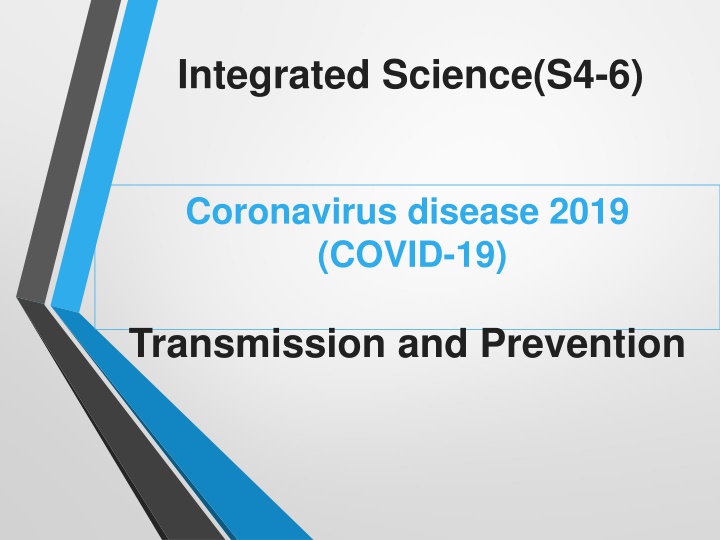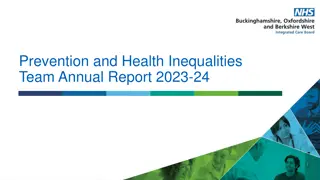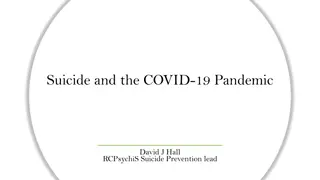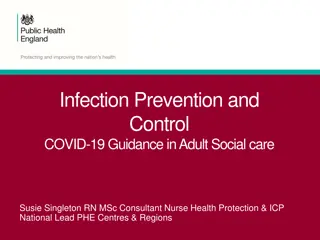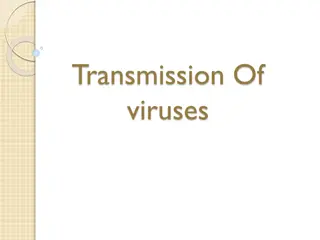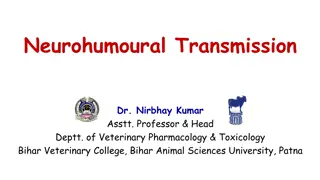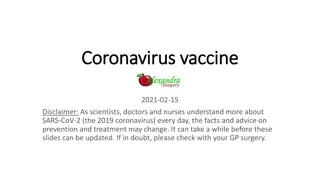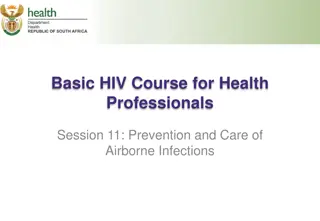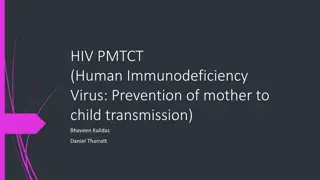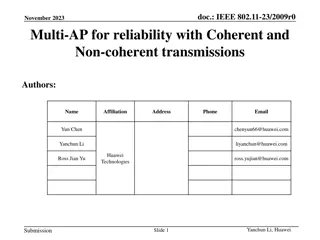COVID-19 Transmission and Prevention
This material covers key learning points about COVID-19, the nature of viruses, virus life cycle, mechanisms of novel virus emergence using Avian Influenza as an example, and transmission of pathogens. It also includes an activity investigating the mode of COVID-19 transmission. The content aims to educate students on infectious diseases, prevention methods, and fostering a sense of community health responsibility.
Download Presentation

Please find below an Image/Link to download the presentation.
The content on the website is provided AS IS for your information and personal use only. It may not be sold, licensed, or shared on other websites without obtaining consent from the author.If you encounter any issues during the download, it is possible that the publisher has removed the file from their server.
You are allowed to download the files provided on this website for personal or commercial use, subject to the condition that they are used lawfully. All files are the property of their respective owners.
The content on the website is provided AS IS for your information and personal use only. It may not be sold, licensed, or shared on other websites without obtaining consent from the author.
E N D
Presentation Transcript
Integrated Science(S4-6) Coronavirus disease 2019 (COVID-19) Transmission and Prevention
Key Learning Points Let students know about the infectious disease - coronavirus disease 2019 (COVID-19) Let students know about how to prevent pneumonia and respiratory tract infections ( COVID-19) To cultivate a sense of responsibility for community health in students To nurture students care for patients and elderly
Virus Virus Non-living by itself, and cannot reproduce unless inside suitable host cells Have simple structures. They consist of genetic material (can be DNA or RNA) encased in a protein coat. Some viruses also have an outer envelope They are very small, about 0.02 to 0.2 m in diameter Each type of virus has a specific protein coat, which attaches to particular types of cells (e.g. pneumonia viruses attach to lung cells) Transmission Electron Micrograph of viruses. (x100000)
The mechanism of the emergence of novel virus (Avian Influenzaas an example) Some animals are the natural reservoir of the particular microorganism Under certain circumstances, such as changes in the genetic material of the pathogen (mutation) or environmental changes, the pathogens may be transmitted to humans and cause disease. Example: Avian Influenza Reservoir Reference: Centre for Health Protection, Department of Health-Avian Influenza https://www.chp.gov.hk/en/healthtopics/content/24/13.html
Transmission of pathogens Infectious diseases are spread from one host to another The pathogens (i.e. different kinds of disease-causing microorganisms) multiply themselves in the host and the microorganisms reproduced are spread to other individuals Different microorganisms are transmitted by different modes of transmission
Activity 1: Investigate the mode of transmission of coronavirus disease 2019 (COVID-19 ) Make reference from the website of the Center for Health Protection of the Department of Health (2019 Coronavirus Diseases Page) and fill in the following table: https://www.coronavirus.gov.hk/eng/index.html Air borne/ Direct Contact Coronavirus disease 2019 (COVID-19 ) Examples of diseases Portal of entry of pathogens into host Nose, Mouth Location of growth of pathogens inside the host Airway, Lungs Sneezing, Coughing (Some information indicate that the virus can leave the host via faeces) Portal of exit of pathogens from the host
The chain of infection There are six essential links of transmission of diseases, called the chain of infection All the components in the chain must be present for an infection to occur Precautions can be taken to reduce disease transmission by breaking the chain of infection Removing any one link stops the transmission of the infectious disease
Prevention of coronavirus disease 2019 (COVID-19) There is no vaccine for this infectious disease at the moment To maintain at all times strict personal hygiene (e.g. wash hands thoroughly) is key to protection against infection of the coronavirus disease. When travelling outside Hong Kong, avoid touching animals; do not consume game meat; and avoid visiting wet markets, live poultry markets or farms
Activity 2: Group project - Mode of transmission of infectious diseases Each group with 3-4 students is responsible for searching information on an infectious disease. The group findings should be presented in class in the form of PowerPoint slides or poster, etc. Information to be searched by each group: The pathogen that causes the disease How the pathogen enters the host , where it grows inside the host , and how it leaves the host Symptoms Mode of transmission Methods to prevent or reduce transmission Please refer to the Health Protection Center of the Department of Health (Infectious Diseases Page) https://www.chp.gov.hk/en/healthtopics/24/index.html
Reference websites: 1. Centre for Health Protection, Department of Health https://www.chp.gov.hk/en/index.html 2. Latest Situation of Coronavirus Disease (COVID-19) in Hong Kong https://chp-dashboard.geodata.gov.hk/covid-19/en.html 3. National Health Commission of the People s Republic of China http://www.nhc.gov.cn/ 4. World Health Organisation Coronovirus disease (COVID-19) outbreak https://www.who.int/emergencies/diseases/novel- coronavirus-2019
Other reference videos Prevention of pneumonia and respiratory tract infection https://www.youtube.com/watch?v=QA_TRNFf5tU &feature=youtu.be Prevent diseases Maintain good hygiene https://www.youtube.com/watch?v=X0OxrsgAP2w
More to know: Influenza Influenza Influenza caused by the influenza virus The various forms of influenza viruses have different types of H proteins and N proteins on the outer envelope and they are named accordingly H protein N protein Influenza virus type Host Type 1 Type 1 H1N1 Humans, pigs, birds Type 2 Type 2 H2N2 Humans, pigs, birds Type 3 Type 2 H3N2 Humans, pigs, birds Type 5 Type 1 H5N1 Birds (occasionally humans) Type 7 Type 7 H7N7 Birds (occasionally humans) Type 9 Type 2 H9N2 Birds (occasionally humans)
